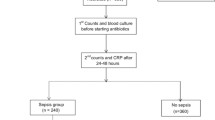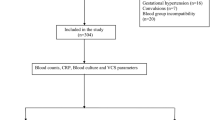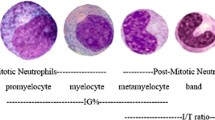Abstract
This study was done to evaluate the role of automated volume, conductivity and scatter (VCS) parameters of neutrophils as indicators of sepsis and its differentiation from other inflammatory disorders. In this cross-sectional study, 225 patients with culture proven or with clinical evidence of sepsis were included along with an equal number of healthy controls. In addition, 138 patients with non-infective inflammatory conditions-acute pancreatitis (50), burns (45) and acute myocardial infarction (43) were also included. Complete blood count was done on LH750 automated hematology analyser (Beckman Coulter). VCS data; mean neutrophil volume (MNV), mean neutrophil conductivity (MNC) and mean neutrophil scatter (MNS) for all patients was recorded. MNV was high (p < .0001) while MNS was lower (p < .0001) in patients with sepsis compared to the control group. MNC was comparable between the two groups (p = .4735). On subgroup analysis of patients with sepsis, significant difference in MNV (p = .0009) and MNS (p = .0210) was observed in patients with leukopenia, normal TLC and leucocytosis. Youden Index was maximum (71%) at MNV of 144.6 (sensitivity-82.7%; specificity-88.5%) and MNV of 147.9 (sensitivity-75.6%; specificity-95.6%) for sepsis. On comparing patients with sepsis with acute pancreatitis and myocardial infarction, MNV and MNC were significantly higher in patients with sepsis. MNV is a useful, inexpensive parameter which can be accessed during a routine CBC run from the raw data. It can be utilized as an early indicator of sepsis as an adjunct to the clinical diagnosis in suspect patients. However, its availability in only select hematology analyzers may limit its use.



Similar content being viewed by others
Availability of Data and Material
Yes, all raw data is available if required.
References
Munford RS (2015) Severe sepsis and septic shock. In: Kasper DL, Hauser SL, Jameson JL, Fauci AS, Longo DL, Loscalzo J (eds) Harrison’s principles of internal medicine, 19th edn. McGraw-Hill, New York, pp 1751–1759
Gleckman R, Hibert D (1982) Afebrile bacteremia. A phenomenon in geriatric patients. JAMA 248:1478–1481
Castle SC, Norman DC, Yeh M, Miller D, Yoshikawa TT (1991) Fever response in elderly nursing home residents: are the older truly colder? J Am Geriatr Soc 39:853–857
Vincent JL, Beumier M (2013) Diagnostic and prognostic markers in sepsis. Exp Rev Anti Infect Ther 11:265–275
Wenz B, Gennis P, Canova C, Burns ER (1986) The clinical utility of the leukocyte differential in emergency medicine. Am J Clin Pathol 86:298–303
Briggs C, Bain J (2017) Basic haematological techniques. In: Bain BJ, Bates I, Laffan MA, Lewis SM (eds) Dacie and Lewis: practical haematology, 12th edn. Elsevier, Oxford, pp 38–39
Chung HN, Jong WC, Lee J (2008) Delta neutrophil index in automated immature granulocyte counts for assessing disease severity of patients with sepsis. Ann Clin Lab Sci 38:241–245
Tejeswini V, Kande S, Premalatha P (2012) Correlation of granularity index with toxic granulation of neutrophils by manual microscopy and C-reactive protein. IOSR J Dent Med Sci 3:35–39
Chaves F, Tierno B, Xu D (2005) Quantitative determination of neutrophil VCS parameters by the Coulter automated hematology analyzer: new and reliable indicators for acute bacterial infection. Am J Clin Pathol 124:440–444
Suresh PK, Minal J, Rao PS, Ballal K, Sridevi HB, Padyana M (2016) Volume conductivity and scatter parameters as an indicator of acute bacterial infections by the automated haematology analyser. J Clin Diagnostic Res 10:EC01–EC03
Purohit A, Kumar P, Sharma S, Kapil A, Gupta A, Mukhopadhyay A (2015) Volume, conductivity, and scatter parameters as diagnostic aid to bacterial sepsis: a tertiary care experience. Indian J Pathol Microbiol 58:459–463
Chaves F, Tierno B, Xu D (2006) Neutrophil volume distribution width: a new automated hematologic parameter for acute infection. Arch Pathol Lab Med 130:378–380
Lee AJ, Kim SG (2013) Mean cell volumes of neutrophils and monocytes are promising markers of sepsis in elderly patients. Blood Res 48:193–197
Mardi D, Fwity B, Lobmann R, Ambrosch A (2010) Mean cell volume of neutrophils and monocytes compared with C-reactive protein, Interleukin-6 and white blood cell count for prediction of sepsis and nonsystemic bacterial infections. Int J Lab Hematol 32:410–418
Bagdasaryan R, Zhou Z, Tierno B, Rosenman D, Xu D (2007) Neutrophil VCS parameters are superior indicators for acute infection. Lab Hematol 13:12–16
Singer M, Deutschman CS, Seymour CW, Shankar-Hari M, Annane D, Bauer M (2016) The third international consensus definitions for sepsis and septic shock (Sepsis-3). JAMA 315:801–810
Coulter®3D VCS technology. Coulter International Corporation. 1996. [Cited 2021 May 3]: http://www.cyto.purdue.edu/cdroms/cyto2/6/coulter/ss000125. html
Park DH, Park K, Park J, Park HH, Chae H, Lim J et al (2011) Screening of sepsis using leukocyte cell population data from the Coulter automatic blood cell analyzer DxH800. Int J Lab Hematol 33:391–399
Villanueva E III, Almirol BJ (2017) The accuracy of mean neutrophil volume relative to blood culture for the diagnosis of sepsis: a meta-analysis. Philip J Pathol 2:18–22
Manning J (2018) Sepsis in the burn patient. Crit Care Nurs Clin North Am 30:423–430
Buyukterzi Z, Gurses K, Erdem S, Sertdemir A, Bor M, Albayrak P (2019) Mean neutrophil volume is elevated in patients suffering from acute coronary syndrome. Kocaeli Med J 121:74–80
Saha D, Adiga DSA, Karthick RG, Priya V, Rao PS, Suresh PK (2020) The role of volume, conductivity, scatter changes of neutrophils and monocytes in diagnosis of megaloblastic anemia. Ann Pathol and Lab Med 7:A-563–9
Acknowledgements
This study was conducted at Christian Medical College & Hospital, Ludhiana, Punjab as a thesis for the post graduate MD pathology course for the first author. The authors acknowledge the contribution of Dr. Ranjeet Mashon for help in data retrieval and statistics. The data has been presented as an oral paper by the first author in the 59th Annual Conference of Indian Society of Hematology & Blood Transfusion (ISHBT) October 2018, Kochi, India
Funding
No funding was received for conducting this study.
Author information
Authors and Affiliations
Contributions
SV collected the data, conducted literature search, analysed the data and drafted the manuscript. NK, MSK and MJ conceived the idea, reviewed the literature, analysed the data and drafted the manuscript. MJ was involved in clinical care of patients. All authors have read and approved the final draft.
Corresponding author
Ethics declarations
Conflict of interest
The authors declare that they have no conflict of interest.
Ethics approval
All procedures performed in studies involving human participants were in accordance with the ethical standards of the institutional and/or national research committee and with the 1964 Helsinki Declaration and its later amendments or comparable ethical standards. This study has been approved by the institutional research and ethics committees, and by the Dean (Principal) of the Christian Medical College & Hospital, Ludhiana, Punjab, India, where it was conducted.
Consent to participate
Individual consent from healthy individuals who comprised the control group was taken. Patient consent was waived off by the institutional research committee since all data collected was part of standard care.
Consent for publication
Consent for publishing the research has been obtained by from the institutional research committee. Individual patient consent was waived off by the institutional research committee as this study is based on CBC parameters and no patient identifying information has been used.
Additional information
Publisher's Note
Springer Nature remains neutral with regard to jurisdictional claims in published maps and institutional affiliations.
Rights and permissions
About this article
Cite this article
Vaswani, S., Kakkar, N., Kwatra, K.S. et al. Role of Automated Volume, Conductivity and Scatter (VCS) Parameters of Neutrophils as Indicators of Sepsis. Indian J Hematol Blood Transfus 38, 710–717 (2022). https://doi.org/10.1007/s12288-022-01519-z
Received:
Accepted:
Published:
Issue Date:
DOI: https://doi.org/10.1007/s12288-022-01519-z




